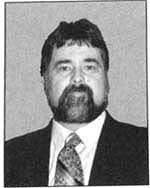All Issues
PM-10 - the unknown compound
Publication Information
California Agriculture 48(4):2-2.
Published July 01, 1994
PDF | Citation | Permissions
Full text
There is a new term to add to the list of historic challenges facing agriculture — PM-10. PM-10 refers to atmospheric particles with an aerodynamic diameter less than or equal to 10 microns. They can settle deeply in the lungs and impair respiratory function. Recent studies indicate that ambient PM-10 levels exceed federal standards in large areas of Central and Southern California (see story, p. 5). Virtually the entire state — excepting Lake County — exceeds the even stricter state standards. Such common agricultural practices as plowing and harvesting create PM-10; large agricultural areas such as the San Joaquin Valley, the Imperial Valley and the Coachella Valley have been asked to submit control plans and show attainment of federal standards by deadlines which range from December 1994 to December of 2001.
The question being asked by agricultural interests concerned about the cost of PM-10 control is: To what extent do farming practices contribute to health problems associated with PM-10? There is no doubt that PM-10 levels exceed state and sometimes federal standards in large areas of California, but the exact composition of PM-10 in agricultural areas has not been well studied. Both federal and state standards were set using data from urban sites. Because federal and state agencies looked at different test populations, the standards set were significantly different ( see p. 6 ). In developing its more stringent standards, the state looked at effects including premature death and respiratory illness. The population at risk included individuals with prior respiratory health problems. The less stringent federal standard was based on reversible respiratory damage in school-age children with normal health status.
There is a major concern about the use of either standard in an agricultural setting. Because of the complex mixture of chemicals in urban PM-10, respiratory problems may have been caused by minute amounts of toxic fine particles that are not necessarily present in agriculturally generated PM-10. Evidence suggests that particulate matter from agricultural operations is significantly different — and possibly less toxic — than PM-10 in urban areas, both by virtue of its average particle size and its chemical constituents.
What happens as these particles penetrate the human body? Each day we inhale and exhale approximately 7,500 liters of air. Air enters through the nose, passes to the top of the trachea and continues through the bronchi and bronchioles, finally reaching the three million or so air sacs deep in the lungs, the alveoli. If the nose is functioning properly the incoming air is warmed and moistened and particulate matter greater than 10 microns is filtered. Soluble gaseous pollutants are almost completely removed by the moist mucus membrane lining. Particulate matter whose size is 2 to 10 microns settles on the walls of the trachea, bronchi and bronchioles.
Particles that are 0.1 to 2 microns can reach the alveoli. Once there, they can remain months or years. This is the site of serious respiratory problems. In a 1991 report to the Legislature,* the California Air Resources Board (ARB) stated “the fine particles contain many compounds that have been identified as toxic, including carcinogenic and mutagenic compounds.”
PM-10 can include solid particles or liquid drops. It can include elements such as lead, nickel or selenium. There may be organic compounds present. Sulfates or nitrates can dominate a given sample. We can group these materials and say that they are products of fuel burned in either mobile or stationary sources, or that they are a result of soil tilling or crop harvesting. Nature can supply its own source of particulate matter through wind blown dust or volcanic eruption.
Theoretically PM-10 can be divided into an infinite number of size increments. Traditionally regulatory agencies look at coarse and fine particles. Coarse particles range in size from 2.5 microns to 10 microns while fine particles are less than 2.5 microns. Fine particles are those that contribute most to degradation of health or to a reduction in visibility.
Agricultural emissions fall into the coarse component of PM-10. The ARB report states, “In contrast to the fine particles the coarse particles consist mainly of soil minerals such as oxides of silicon, aluminum, calcium, and iron. These particles are less likely to contain as much toxic material as the fine particles.”
However, data on the actual composition of agricultural PM-10 is almost completely lacking. For a given area the constituents of PM-10 should be identified as well as their size distribution before requiring procedures to guarantee compliance with state or federal standards. The toxicity of coarse particles must be established. The serious lack of data on agricultural PM-10 has spurred numerous recent research efforts, including some at the Crocker Nuclear Laboratory.
More research is needed to determine whether the standards which apply to urban and industrialized areas should be applied to agricultural areas. Coarse particles consisting mainly of soil minerals may not have the serious health effects associated with PM-10. If research reveals that agriculture does contribute to the PM-10 problem, further studies should determine the best means to mitigate it, whether that be paving roads, screening cropland with windbreaks, or changing harvesting equipment or other practices.
The PM-10 standard was based on the best information at the time. It may be necessary to incorporate information collected since then, differentiating between coarse and fine PM-10, supplying the missing pieces of data, and establishing a new standard that more accurately reflects the human health impact of PM-10 dust in agricultural and rural areas.





